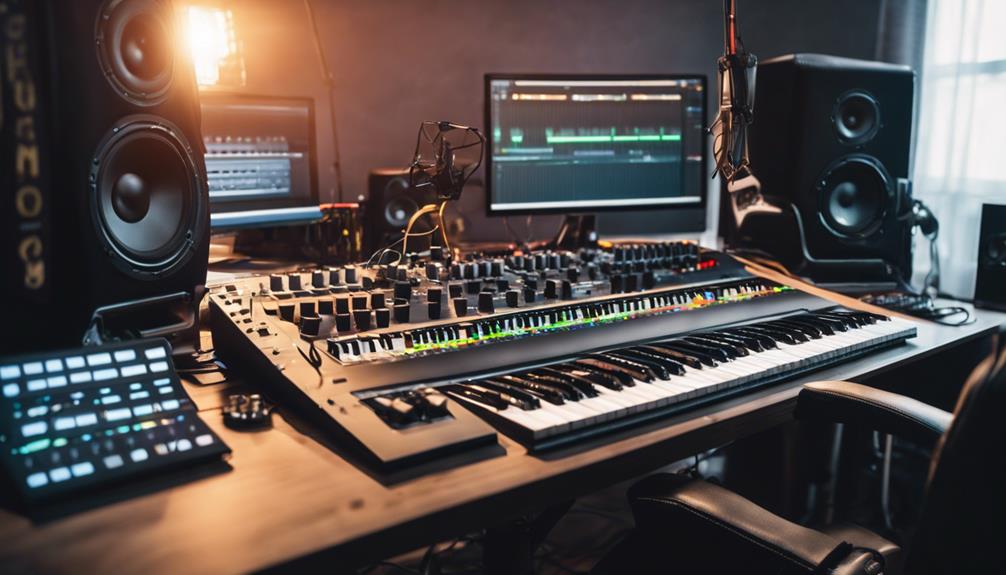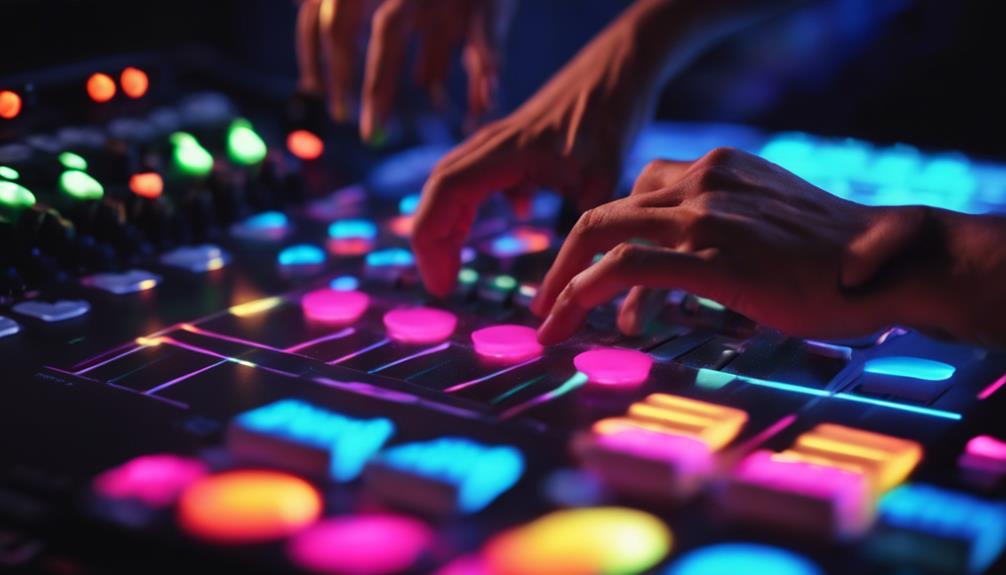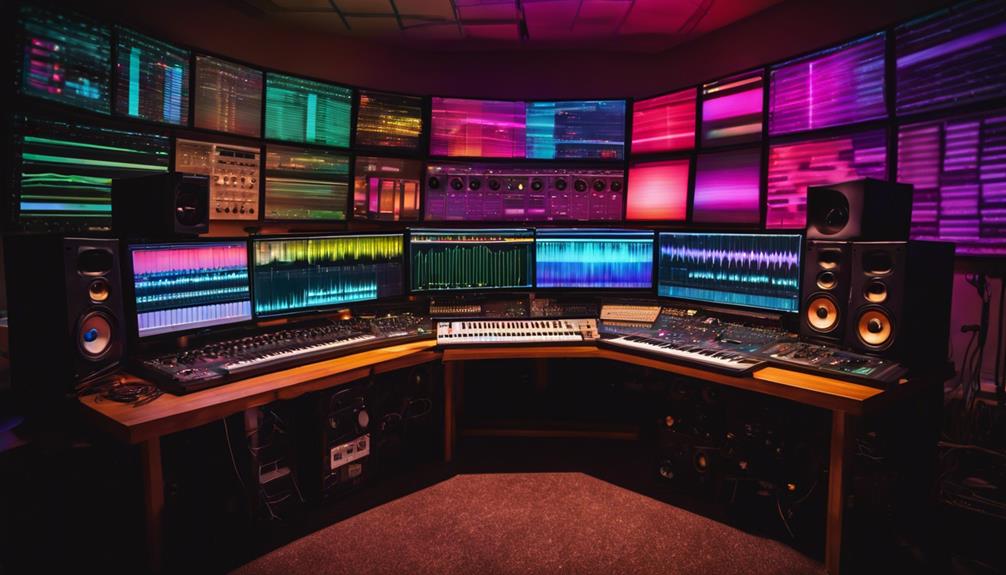When you’re setting out to make beats, the first step is to get your essential equipment in place. You’ll need a digital audio workstation (DAW), a good pair of headphones, and perhaps a MIDI controller. Once you’re set up, defining your vibe becomes essential—think about the genre, tempo, and key that will shape your track. Building a solid rhythm foundation with kick drums, snares, and hi-hats is next, and that’s where things start to get interesting. Are you curious about how to add those alluring melodies that take your beats to the next level?
TL-DR
- Choose a Digital Audio Workstation (DAW) like Ableton Live, FL Studio, or Logic Pro to start creating your beats.
- Lay down the foundation with kick drums, snares, and hi-hats, and experiment with different drum patterns.
- Add melodies using various instruments and synths, and enhance them with harmonies and counter melodies.
- Mix your tracks to achieve a balanced sound, adjusting individual elements for clarity and cohesion.
- Master your beat using software like Ozone to finalize and enhance dynamics, stereo width, and overall sound quality.
Essential Equipment

To start making beats, you’ll need essential equipment like a computer with audio editing software and a digital audio workstation. Your computer will be the hub of your music production, where you’ll install your DAW. This software is vital for recording, editing, and producing your audio tracks. Popular DAWs include Ableton Live, FL Studio, and Logic Pro.
MIDI controllers are a fantastic addition to your setup, offering a hands-on approach to beat making. They allow you to play and record MIDI data directly into your DAW, making the creative process more intuitive. Pairing your DAW with quality headphones and monitors is essential for accurate sound monitoring and mixing. Headphones are great for detailed listening, while monitors give you a true representation of your audio in a room setting.
Don’t overlook the value of loop and sample libraries. These collections of pre-recorded audio snippets can be manipulated and combined to create unique beats. Libraries like Splice or Loopmasters offer a vast array of sounds to inspire and enhance your projects.
With this essential equipment in place, you’re well on your way to creating impressive beats.
Defining Your Vibe
With your essential equipment set up, the next step is defining your vibe to shape the mood and energy of your beat. Start by considering the genre you want to explore. Whether it’s hip-hop, electronic, or jazz, each genre has its own unique vibe.
Next, think about the tempo and key. A faster tempo can add energy and excitement, while a slower one can create a more relaxed or melancholic mood. Similarly, choosing between a major or minor key will have a substantial impact on the emotions your beat conveys.
Reflect on the mood and emotions you want to express. Are you aiming for a happy, upbeat feel or something darker and more introspective? This will guide your creative decisions throughout the process. Also, consider your target audience. What kind of emotions do you want them to experience when they listen to your beat? Understanding your audience can help you make more focused choices.
Personal experiences and inspirations play an important role in defining your vibe. Use them to infuse authenticity and depth into your music. Establishing a clear vibe not only guides your creative decisions but also ensures your beat resonates with your target audience effectively.
Building the Rhythm

Kicking off the rhythm-building process, start by laying down a solid foundation with essential elements like kick drums, snares, and hi-hats. These core components form the backbone of your rhythm. Experiment with different drum patterns and rhythms to carve out a unique groove.
A consistent kick drum pattern provides the heartbeat, while snares add punch and hi-hats offer the crispness that keeps everything tight.
To make your rhythm more engaging, layer various percussion sounds. Adding congas, shakers, or claps can introduce depth and complexity. Don’t be afraid to experiment with unconventional drum sounds to stand out.
Utilize swing or shuffle settings to inject a natural, human feel into your drum patterns. This slight off-beat timing can make your track feel more alive.
Pay close attention to the spacing and timing of each drum hit. Proper spacing guarantees that your rhythm doesn’t sound cluttered, while precise timing allows the different elements to interact smoothly.
Crafting a cohesive rhythm involves balancing all these elements. Make sure your drum patterns flow well together, creating an engaging and dynamic beat. This solid rhythmic foundation will anchor the rest of your track, setting you up for success in the next steps.
Adding Melodies
Explore
Crafting compelling melodies is essential for breathing life and emotion into your beat. Melodies are those musical phrases or sequences that make your track memorable and engaging.
Start by exploring different instruments and synths in your beat-making software. Whether you’re using a piano, guitar, or electronic synths, each choice will shape the vibe and mood of your beat.
Don’t be afraid to experiment with various samples as well. Sometimes, a unique sample can spark inspiration and lead to a standout melody. As you layer your melodies, think about how they enhance the overall composition. Are they adding the right emotional tone?
Adding harmonies and counter melodies can take your beat to the next level. Harmonies will enrich the core melody, bringing depth and complexity. Counter melodies, on the other hand, can provide an interesting interplay that keeps the listener engaged.
Remember to experiment and tweak until you find the perfect combination that resonates with your vision. Your beat-making software offers countless possibilities, so explore and let your creativity flow. The right melodies will elevate your beat and make it truly unforgettable.
Mixing and Mastering

Once you’ve crafted your melodies, it’s time to focus on mixing and mastering to make certain your beat sounds polished and professional. Mixing involves adjusting individual tracks to create a cohesive sound. You’ll need to make track adjustments like setting volume levels, panning, and tweaking EQ settings.
Software like Neutron is excellent for this task, allowing you to fine-tune each element in your beat for the perfect balance.
After you’ve got your mix sounding right, it’s time to move on to mastering. Mastering is all about finalizing the overall mix to make sure it sounds great on all playback systems. Ozone is a popular choice for this stage, helping you polish tracks by enhancing clarity and dynamics.
The software allows you to add the final touches that make your beat stand out, such as adjusting the stereo width and applying gentle compression to glue everything together.
Next up, learn about mixing and mastering music in this guide.
